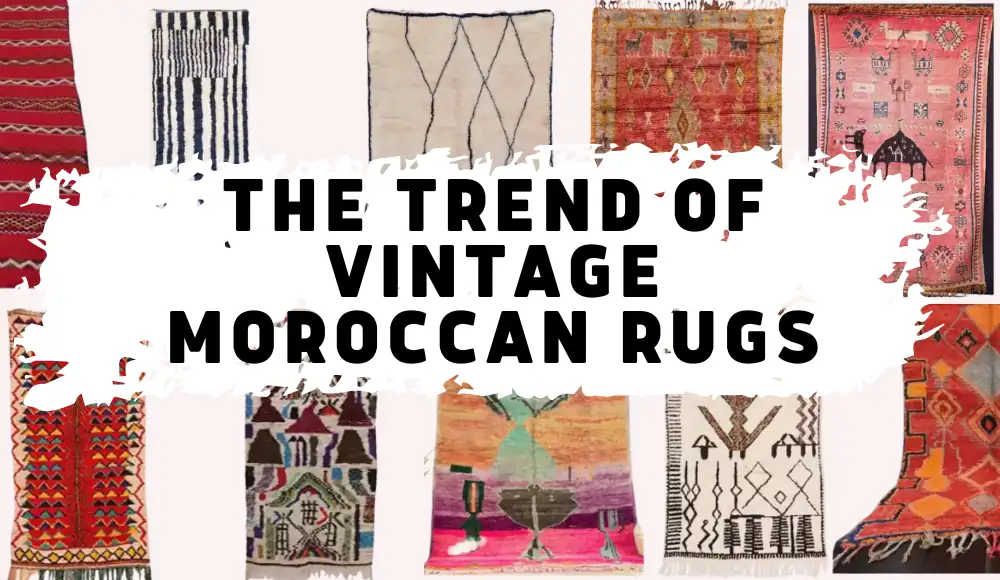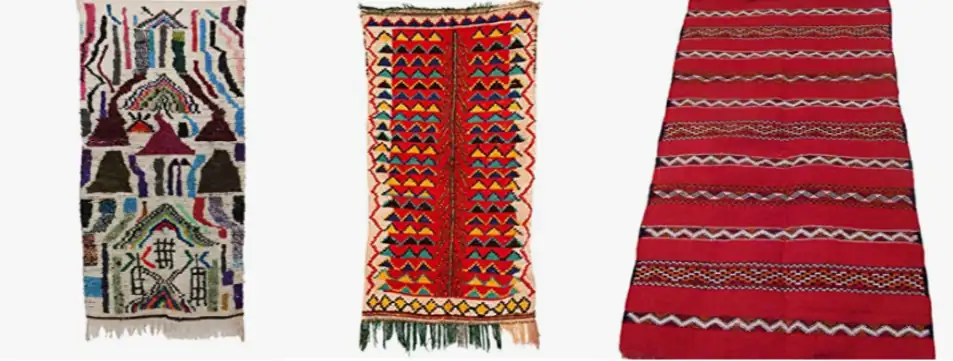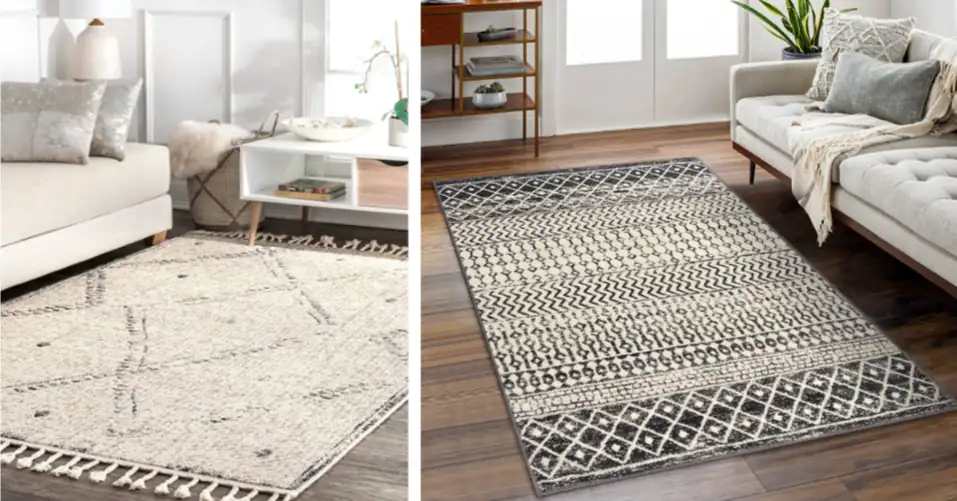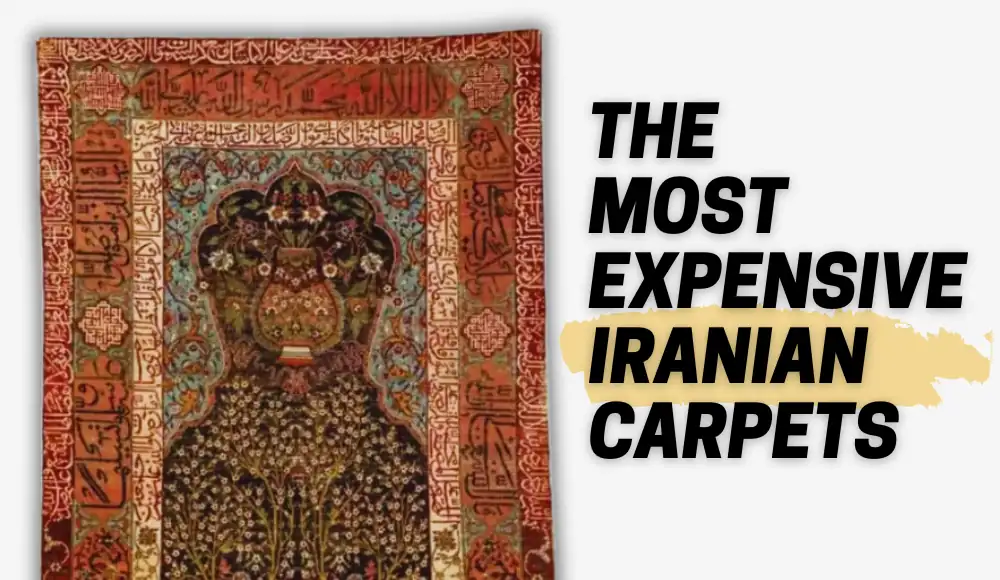Last updated on May 5th, 2023 at 04:58 am
Moroccan rugs have been handcrafted for centuries by the Berber tribes in the Atlas Mountains. These rugs are known for their unique designs and patterns that showcase the rich cultural heritage, folklore, and artistic expression of the Berber people.

The wool used in these rugs is sourced locally and expertly spun by hand, imparting a softness and durability that lasts for generations.
Each rug is made with care and attention to detail, resulting in a one-of-a-kind work of art that tells the story of its maker.
Why vintage Moroccan rugs are highly sought after
You may already heard a lot about Moroccan rugs and also may wonder, why are Moroccan rugs so expensive.
Vintage Moroccan rugs are highly prized by collectors, designers, and homeowners alike due to their distinct aesthetic appeal. These pieces boast an organic feel that is hard to replicate with modern manufacturing techniques.
They bring warmth, texture, and personality to any space.
Handcrafted colorful Moroccan rug
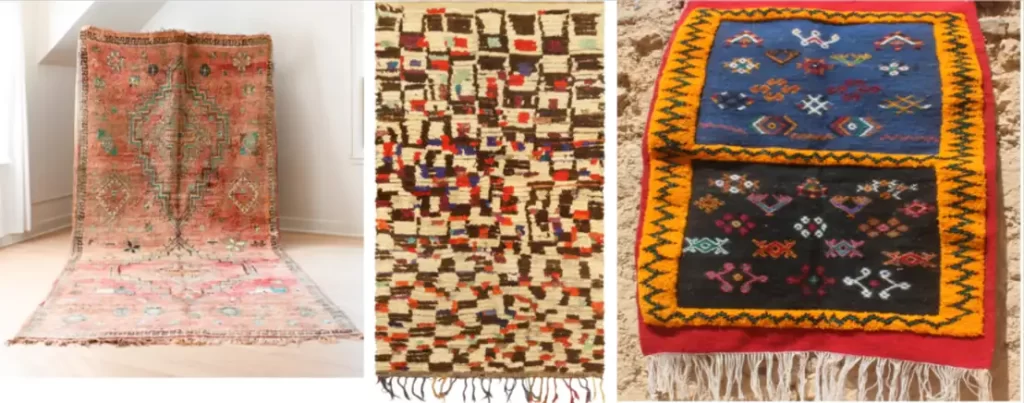
In addition to their visual appeal, vintage Moroccan rugs also represent an important piece of cultural heritage that has been passed down through generations.
Owning one is not just about having a beautiful piece in your home; it’s also about preserving a legacy and connecting with a culture that has stood the test of time.
The stories behind each rug make them truly special and add depth to any collection or design project.
Characteristics of Vintage Moroccan Rugs
Unique designs and patterns
Vintage Moroccan rugs are known for their intricate and unique designs. These rugs typically feature geometric shapes, with diamonds, triangles, and squares being the most common.
The designs often have a tribal feel to them, which is a nod to the history of the Berber tribes that created these rugs. One of the most notable aspects of vintage Moroccan rug designs is their asymmetry.
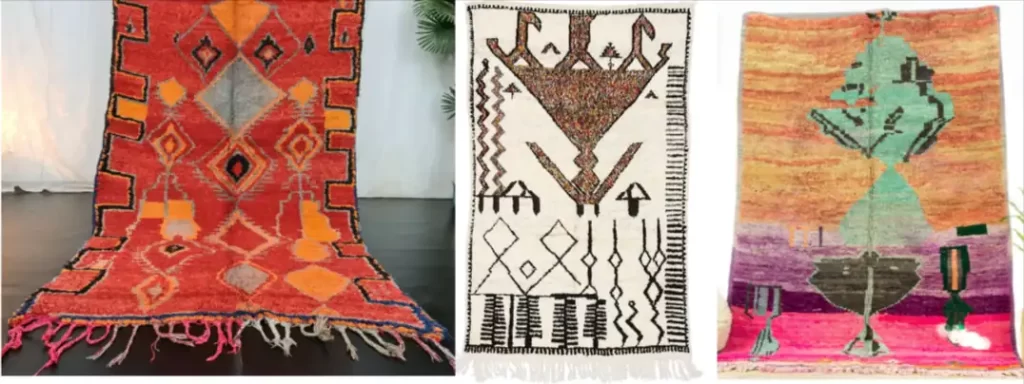
Unlike traditional Persian rugs which are known for their symmetry and uniformity, Moroccan rugs feature irregular lines and shapes that give them a more organic feel. This creates a sense of movement in the design that can be visually stimulating and captivating.
Natural materials used in their creation
Another defining characteristic of vintage Moroccan rugs is the use of natural materials in their creation.
Most often, these rugs are made from wool sourced from local sheep, which gives them a soft yet durable texture.
Additionally, cotton may be used for details or as a base for some types of vintage Moroccan rugs. The natural dyes used to create colors in vintage Moroccan rugs are also important to note.
These dyes come from plant-based sources such as henna leaves and saffron flowers, which give the colors an earthy tone. Over time, these colors may fade slightly due to sun exposure or regular use, but this only adds to the rug’s unique character.

What is the use of henna leaves? Henna leaves are commonly used to create a natural dye that is used to color hair, skin, and nails. The dye is created by crushing the henna leaves into a powder and mixing it with water or other liquids to form a paste. This paste is then applied to the hair, skin, or nails, and left to dry. After several hours, the paste is washed off, leaving behind a reddish-brown stain.
Henna has been used for centuries in many cultures around the world as a natural form of body art and beauty treatment. In addition to coloring hair and skin, the henna paste can be used to create intricate designs and patterns on the skin, known as mehndi or henna tattoos. Henna is also believed to have medicinal properties and is used in some traditional medical practices.
Different types of vintage Moroccan rugs (e.g. Beni Ourain, Azilal)
There are several different types of vintage Moroccan rugs available on the market today, each with its own set of unique characteristics.
Beni Ourain rug
One popular type is the Beni Ourain rug which originated in Morocco’s Atlas Mountains region. These rugs are known for their shaggy texture made from thick wool piles that provide warmth during cold winter months.
Azilal rug
Another type is the Azilal rug, which features more colorful and intricate designs created by Berber women. These rugs are typically made with wool and cotton, and their playful patterns can add a vibrant pop of color to any room.
Overall, vintage Moroccan rugs offer a unique way to infuse character and style into any space. Whether you’re drawn to the asymmetrical designs or the natural materials used in their creation, these beautiful works of art are sure to make a statement in your home.
How to Identify Authentic Vintage Moroccan Rugs
Materials Used (e.g. wool, cotton)
How can you tell if a Moroccan rug is real?
If you’re looking to purchase a vintage Moroccan rug, it’s important to know what materials were traditionally used in their creation. Most Moroccan rugs are made with wool or cotton, although some may incorporate silk or other natural fibers.
Wool was often the primary material used due to its durability and warmth.
When inspecting a rug, check for signs of wear and tear that may indicate the age of the piece. When it comes to determining the quality of the wool used in a vintage Moroccan rug, look for softness and sheen.
High-quality wool will feel soft and silky to the touch, while lower-quality wool may feel coarser or rougher.
Additionally, inspect the pile density – high-quality wool will create a dense pile that feels plush underfoot.
Knotting Techniques
One way to identify an authentic vintage Moroccan rug is by examining its knotting techniques. Traditional Moroccan rugs are often made using one of two knotting techniques: asymmetric or symmetric knots.
Asymmetric knots are more commonly used in Moroccan rugs and create a slightly looser weave with a shaggy appearance. To identify these knots, examine the backside of the rug – you should see small bumps formed from each individual knot tied by hand by skilled weavers who use them as prayer mats on which they can kneel.
Design Elements
One of the most distinctive features of vintage Moroccan rugs is their unique designs and patterns.
Geometric shapes like diamonds, triangles, and squares are common design elements found in many traditional Moroccan rugs – often with asymmetrical variations seen in Berber tribes’ creations.
You can also find motifs inspired by nature such as animals like lions or flowers like chrysanthemums woven into these pieces that reflect tribal identity.
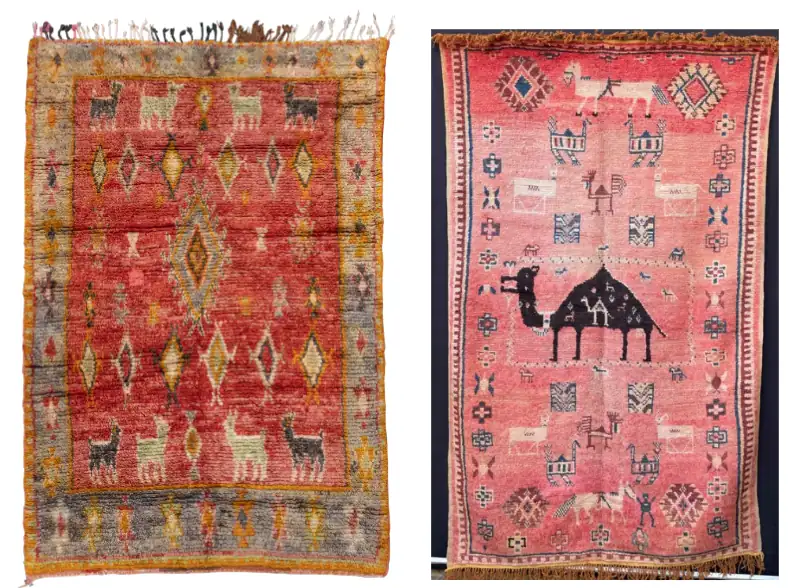
Additionally, Moroccan rugs often feature bold, vibrant colors that make them stand out in any room.
When examining a vintage Moroccan rug’s design, look for details like symmetry, repetition of patterns or motifs, and variations in color shades that add to the piece’s overall beauty.
Caring for Vintage Moroccan Rugs
Regular Cleaning and Maintenance
Vintage Moroccan rugs are not only beautiful but also durable, making them an investment that can last a lifetime.
However, to ensure their longevity, it is important to clean and maintain them regularly. Vacuuming is the best way to remove loose dirt and debris from the rug’s surface.
It is recommended to vacuum your rug once or twice a week or more frequently depending on its location and level of foot traffic.
In addition to regular vacuuming, it is important to rotate your vintage Moroccan rug periodically. This will help prevent uneven wear and tear that can occur in high-traffic areas of the room over time.
You should also avoid placing heavy furniture or objects on top of the rug for extended periods as this can cause permanent damage.
Avoiding Damage from Sunlight and Moisture
Sunlight exposure can cause fading, discoloration, and deterioration of vintage Moroccan rugs over time. To prevent this damage, it is important to keep your rug out of direct sunlight as much as possible.
If you have windows in the room where your rug is located, consider installing UV-protective film on the windows or covering them with drapes or blinds during peak sunlight hours.
Moisture is another enemy of vintage Moroccan rugs. Avoid placing them in damp areas such as basements or bathrooms where moisture levels are high.
If you spill something on your rug, blot it up immediately with a clean cloth or paper towel. Do not scrub the stain vigorously as this may damage the fibers of the rug.
By taking good care of your vintage Moroccan rug through regular cleaning and maintenance while avoiding damage from sunlight and moisture exposure, you can enjoy its beauty for many years to come.
Do vintage Moroccan rugs shed?
All woolen rugs, including vintage Moroccan rugs, will naturally shed fibers over time, especially when they are new.
However, this shedding is normal and should decrease over time with regular use and vacuuming. If shedding continues to be a problem, it may be a sign of poor quality or improper care.
It’s important to follow proper care instructions and avoid using harsh chemicals or excessive agitation when cleaning the rug to minimize shedding.
Overall, shedding should not be a major concern when considering the beauty and durability of a vintage Moroccan rug.
Decorating with Vintage Moroccan Rugs
Incorporating them into different design styles (e.g. bohemian, mid-century modern)
Vintage Moroccan rugs are versatile pieces that can be incorporated into various design styles.
One of the most popular ways to decorate with these rugs is the bohemian style. Bohemian decor is all about mixing and matching textures, colors, and patterns to create an eclectic and free-spirited look.
A vintage Moroccan rug can be used as the centerpiece of a boho-inspired room by layering it on top of other rugs or placing it in front of a low-slung couch or armchair. To complement the rug, add colorful throw pillows, floor cushions, and poufs.
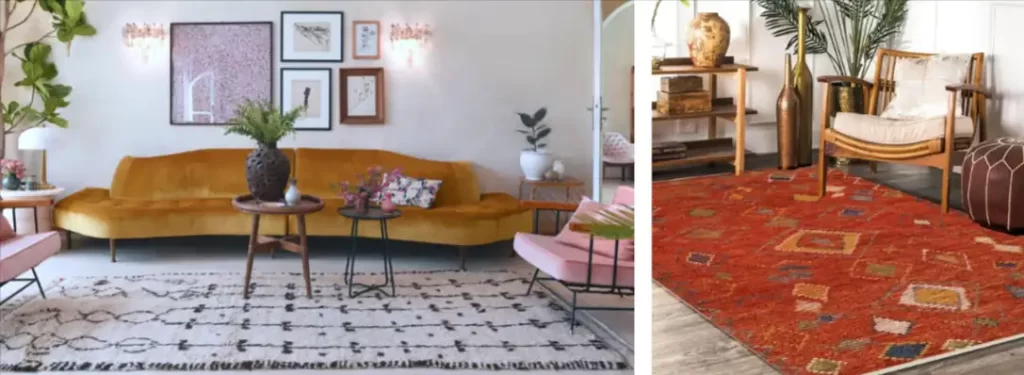
Another design style that pairs well with vintage Moroccan rugs is mid-century modern. This style emphasizes clean lines, organic shapes, and natural materials.

The textured look of a vintage Moroccan rug can add depth to a mid-century modern room without overwhelming its minimalist aesthetic.
A Beni Ourain rug with its simple geometric pattern in black and white can make an excellent addition to this style.
Pairing with other textiles and furniture pieces
When decorating with vintage Moroccan rugs, it’s essential to choose complementary textiles and furniture pieces that will enhance their unique patterns and textures.
For example, pairing a Beni Ourain rug with soft velvet upholstery in rich jewel tones creates a luxurious contrast that adds warmth to any space.
Moroccan area rug in home space

A vintage Azilal rug featuring bright pops of color would pair well with more neutral furnishings in natural materials like wood or leather for balance. Textured fabrics like linen or burlap can also complement these rugs’ natural texture while adding depth to the overall look.
When selecting additional textiles for your space, consider layering different textures like faux fur blankets or knit throws for added coziness during colder months.
With the right pairing, a vintage Moroccan rug can be the perfect piece to tie together your decor and create a cozy and stylish atmosphere.
The Market for Vintage Moroccan Rugs
The popularity of vintage Moroccan rugs has been on the rise over the past few years, with more people appreciating the unique designs and natural materials used in their creations.
As a result, there are now many retailers and resellers offering authentic vintage Moroccan rugs for sale.
However, it’s important to be cautious when shopping for these rugs, as there are also many fakes on the market.
One of the best ways to find authentic vintage Moroccan rugs is by working with reputable rug dealers or interior designers who specialize in these types of rugs.
These experts have a deep understanding of what makes a rug genuine and can help you navigate through the many options available. You can also search online marketplaces such as Amazon, Etsy, eBay, or Chairish, but make sure to do your research before making a purchase.

Small vintage Moroccan carpet on Amazon online marketplace
Where to Find Authentic Vintage Moroccan Rugs
If you’re looking for that perfect vintage Moroccan rug to add character and charm to your home or office space, here are some places where you might find them:
- Rug dealers specializing in vintage Moroccan rugs
- Auctions houses specializing in antique or tribal textiles
- Estate sales or flea markets (although it may take some patience and luck)
- Online marketplaces such as Etsy, Amazon, eBay, or Chairish (make sure to check seller ratings and reviews)
Pricing Considerations
How much is a Moroccan rug worth?
When it comes to pricing for authentic vintage Moroccan rugs, there are several factors that can affect how much they cost.
Some of these factors include:
- The age of the rug – older rugs generally command higher prices due to their rarity.
- The condition of the rug – rugs in excellent condition will be more expensive than those with signs of wear and tear.
- The size of the rug – larger rugs tend to cost more than smaller ones.
- The type of wool used in the rug – high-quality wool from certain sheep breeds can make a rug more valuable.
While prices for vintage Moroccan rugs can vary widely depending on these factors, as well as the seller and market conditions, it’s generally recommended to set aside a budget of at least $500-$1,000 for a quality vintage Moroccan rug.
Conclusion
Vintage Moroccan Rugs: The Perfect Addition to Any Home
Owning vintage rugs and specifically vintage Moroccan rug is a unique and rewarding experience. These rugs are not only beautiful and functional, but they also tell a story of generations past. The unique designs and patterns, natural materials used in their creation, and different types of vintage Moroccan rugs make them highly sought after by collectors and designers alike.
Identifying an authentic vintage Moroccan rug can be an exciting treasure hunt.
Authenticity can be determined by examining the materials used, knotting techniques, and design elements.
Caring for your vintage Moroccan rug is essential in maintaining its beauty and longevity. Regular cleaning and maintenance, as well as avoiding damage from sunlight and moisture, will help preserve your rug for years to come.
Vintage Moroccan rugs provide endless possibilities for decorating your home. Incorporating them into different design styles such as bohemian or mid-century modern can add a unique touch to any room.
Pairing them with other textiles or furniture pieces can create a layered look that adds depth to your decor. In today’s mass-produced world where everything is made by machine, owning a handmade vintage Moroccan rug is truly special.
These rugs bring character to any room they occupy while also preserving traditional techniques that have been passed down from generation to generation. Investing in a vintage Moroccan rug not only means having an authentic piece of history but also supporting the artisans who keep these traditions alive today.
